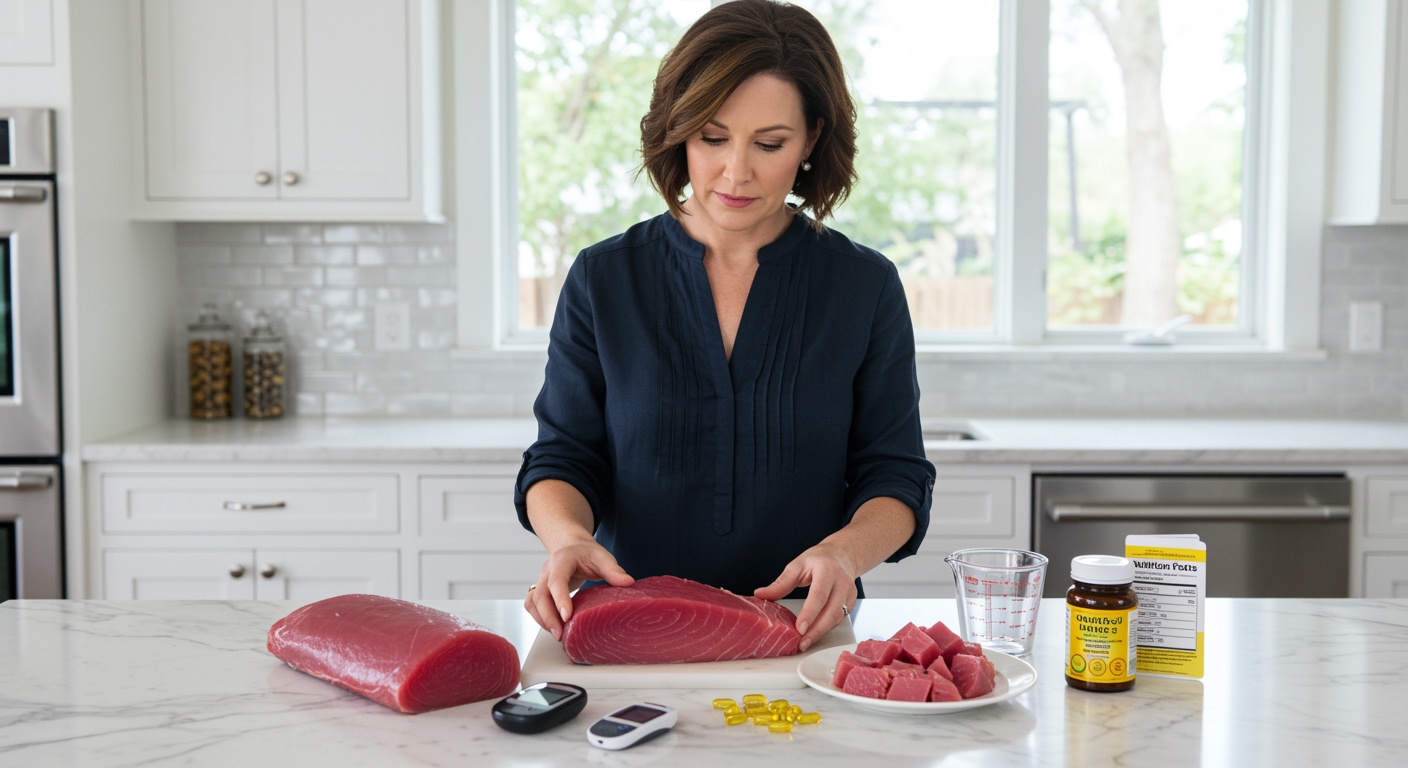✪ Key Takeaway: Tuna is excellent for diabetes because it contains zero carbs, high protein, and omega-3 fatty acids that improve insulin sensitivity.
Introduction
Your doctor tells you to eat more fish, but then you wonder if tuna will spike your blood sugar like other foods seem to do.
You might be asking this question because you want a convenient protein source that fits your diabetes meal plan without causing blood sugar rollercoasters.
Hi, I’m Abdur, your nutrition coach and today I’m going to explain exactly why tuna can be one of your best allies in managing diabetes effectively.
Does Tuna Raise Blood Sugar Levels?
Tuna contains zero carbohydrates, which means it cannot directly raise your blood sugar levels.
When you eat carbohydrates, your digestive system breaks them down into glucose that enters your bloodstream.
Since tuna is pure protein and fat, it bypasses this glucose conversion process entirely.
The glycemic index of tuna is zero, making it one of the safest foods for people with diabetes.
However, your body still needs to process the protein through a mechanism called gluconeogenesis.
This process converts small amounts of protein into glucose, but it happens slowly and creates a minimal blood sugar impact compared to carbohydrate-rich foods.
The protein content in tuna actually helps stabilize blood sugar by slowing down the absorption of any carbohydrates you eat alongside it.
✪ Fact: A 3-ounce serving of tuna provides 25 grams of protein with absolutely zero carbohydrates.
What Makes Tuna Beneficial For Diabetes?
Tuna contains omega-3 fatty acids that research shows can improve insulin sensitivity in people with type 2 diabetes.
These healthy fats help your cells respond better to insulin, which means your body can use glucose more effectively.
The high protein content in tuna also supports muscle maintenance, which is crucial for glucose metabolism.
Muscle tissue acts like a glucose storage facility, and having more lean muscle mass helps your body handle blood sugar fluctuations better.
Tuna provides selenium, a mineral that supports antioxidant function and may help protect against diabetes complications.
The B vitamins in tuna, particularly B12 and niacin, support energy metabolism and help your body convert nutrients into usable energy efficiently.
Unlike processed meats that often contain added sugars or starches, plain tuna gives you pure nutrition without hidden carbohydrates that could affect your blood sugar.
✪ Pro Tip: Choose tuna packed in water rather than oil to avoid extra calories that could affect weight management.
Are There Any Risks With Eating Tuna?
The main concern with tuna consumption is mercury content, which can be higher in larger fish species like albacore tuna.
Mercury accumulates in your body over time and can affect nervous system function if consumed in excessive amounts.
However, this risk is manageable through portion control and choosing the right types of tuna.
Light tuna typically contains less mercury than white albacore tuna, making it a safer choice for regular consumption.
The sodium content in canned tuna can be significant, especially if you have high blood pressure alongside diabetes.
Some canned tuna products contain added salt for preservation, which could contribute to cardiovascular complications if consumed excessively.
Fresh or frozen tuna generally contains less sodium than canned varieties, making it a better choice for people managing multiple health conditions.
✪ Note: Limit tuna consumption to 2-3 servings per week to minimize mercury exposure while maximizing health benefits.
How Should You Include Tuna In Your Diabetes Diet?
Start with 3-ounce servings of tuna 2-3 times per week as part of your regular meal rotation.
This amount provides excellent protein without overwhelming your system with mercury or excessive calories.
Pair tuna with non-starchy vegetables like leafy greens, bell peppers, or cucumber to create balanced meals that support stable blood sugar.
The fiber in vegetables slows down digestion and helps prevent any potential blood sugar spikes from other meal components.
Avoid mixing tuna with high-carbohydrate foods like white bread, crackers, or pasta if you want to maintain optimal blood sugar control.
Instead, try tuna salad over mixed greens, tuna-stuffed avocados, or grilled tuna steaks with roasted vegetables.
Prepare tuna with healthy fats like olive oil or avocado rather than mayonnaise to maximize the nutritional benefits while keeping calories reasonable.
✪ Pro Tip: Add lemon juice and herbs to tuna instead of heavy sauces to enhance flavor without adding carbohydrates.
The Bottom Line
Tuna is not just safe for diabetes management, it can actually help improve your blood sugar control through its zero-carb profile and beneficial nutrients.
The best foods for diabetes are often the simplest ones that nature provides without human interference.
I would love to hear about your experience with including tuna in your diabetes meal plan, so please share your thoughts, questions, or favorite tuna recipes in the comments below.
References
At NutritionCrown, we use quality and credible sources to ensure our content is accurate and trustworthy. Below are the sources referenced in creating this article:
- Number Analytics: Tuna Insulin Sensitivity Health Benefits
- FoodStruct: Tuna Nutrition Facts
- Klinio: Tuna and Diabetes
- Healthline: Low Glycemic Diet





